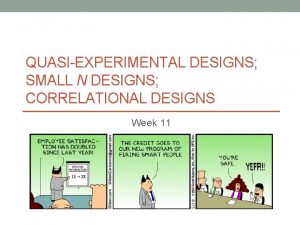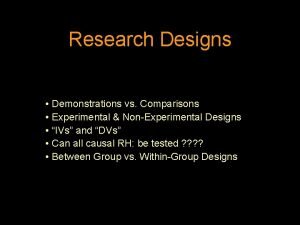Experimental design 2 Good experimental designs have high

















- Slides: 17

Experimental design 2:

Good experimental designs have high internal validity: To unequivocally establish causality, we need to ensure that groups in our study differ systematically on our intended independent variable(s) and not on other confounding variables as well.

Threats to the internal validity of an experiment's results (e. g. Campbell and Stanley 1969): Time threats: History Maturation Selection-maturation interaction Repeated testing Instrument change Group threats: Initial non-equivalence of groups Regression to the mean Differential mortality Control group awareness of its status. Participant reactivity threats: Experimenter effects, reactivity, evaluation apprehension.

Types of experimental design: 1. Quasi-experimental designs: No control over allocation of subjects to groups, or timing of manipulations of the independent variable. (a) “One-group post-test" design: Prone to time effects, and no baseline against which to measure effects - pretty useless!

(b) One group pre-test/post test design: Now have a baseline against which to measure effects of treatment. Still prone to time effects. Statistics marks 2006 course change Statistics marks 2007

(c) Interrupted time-series design: measurement time measurement treatment measurement Still prone to time effects.

(c) Interrupted time-series design (cont. ): Deaths for Friday nights, 10 -12 pm; Saturday and Sunday nights, 10 pm - 4 am. Vertical line: implementation of British Road Safety Act, Oct. 1967 (Ross, Campbell & Glass, 1970).

(c) “Static group comparison" design: group A: treatment (experimental gp. ) measurement group B: no treatment (control gp. ) measurement Subjects are not allocated randomly to groups; therefore observed differences may be due to pre-existing group differences.

2. True experimental designs: (a) Post-test only/control group" design: group A: treatme nt (experimental gp. ) measurement group B: no treatment (control gp. ) measurement random allocation: Random allocation of subjects to groups should ensure that observed differences are not due to pre-existing group differences - but can't be certain!

(b) Pre-test / post-test control group" design: random allocation: gro up A: measurement treatment measurem ent group B: measurement no treatment measurement Ensures that groups are indeed comparable before the experimental manipulation was administered.

(c) Solomon four group design: group A: group B: random allocation: group C: group D: measurement treatment measurement no treatment measurement Ensures that groups are indeed comparable before the experimental manipulation was administered, and that pre-testing hasn't affected performance. (Uses lots of subjects, so rarely used).

Between-groups versus within-subjects designs: Between-groups (independent measures) Each subject participates in only one condition of the study. e. g. sex differences in memory. Within-subjects (repeated measures) Each subject does all of the conditions in a study. e. g. effects of alcohol on memory. Mixed designs Mixture of both. e. g, sex differences in effects of alcohol on memory.

Advantages and disadvantages of between-groups and within-subjects designs: Ease of design Between groups Within subjects Straightforward. Can be more complicated. Number of More subjects required Fewer Carry-over effects between conditions No Possible Sensitivity to experimental effects Lower Higher Reversibility of conditions Unimportant Essential

Within-subjects designs and order effects: Order effects: practice, fatigue, boredom. A fixed order of conditions would cause order to vary systematically with condition - results are uninterpretable, because they could be due to order effects, experimental manipulations or both. Solutions: (a) Randomise order of conditions: e. g. with 3 conditions, subjects randomly get orders ABC, BCA, ACB, CBA, CAB, BAC. (b) Counterbalance order of conditions: e. g. equal numbers of subjects get each order.

A simple within-subjects design: subject 2: time treatment A measurement A subject 1: treatment B measurement A treatment A measurement A

Disadvantages of the experimental method: Intrusive - participants know they are being observed, and this may affect their behaviour. Experimenter effects. Not all phenomena are amenable to experimentation, for practical or ethical reasons (e. g. post-traumatic stress disorder, near-death experiences, effects of physical and social deprivation, etc. ) Some phenomena (e. g. personality, age or sex differences) can only be investigated by methods which are, strictly speaking, quasi-experimental.

Conclusion: Experiments are a useful tool for establishing cause and effect - but other methods (e. g. observation) are also important in science. A good experimental design ensures that the only variable that varies is the independent variable chosen by the experimenter - the effects of alternative confounding variables are eliminated (or at least rendered unsystematic by randomisation).
 Experimental vs nonexperimental
Experimental vs nonexperimental 11 principles of design
11 principles of design Randomized design
Randomized design Design meaning in research
Design meaning in research Basic principles of experimental designs
Basic principles of experimental designs Quasi-experimental research designs
Quasi-experimental research designs Quasi-experimental research designs
Quasi-experimental research designs Solomon four group design
Solomon four group design Good thought good deeds good words
Good thought good deeds good words C. good evening.
C. good evening. Good afternoon teacher
Good afternoon teacher Nothing compares to your embrace
Nothing compares to your embrace Good afternoon morning
Good afternoon morning Let's be good friends
Let's be good friends Experimental vs non experimental
Experimental vs non experimental Quasi experimental design example
Quasi experimental design example Experimental vs non experimental research
Experimental vs non experimental research Nonexperimental study
Nonexperimental study

































